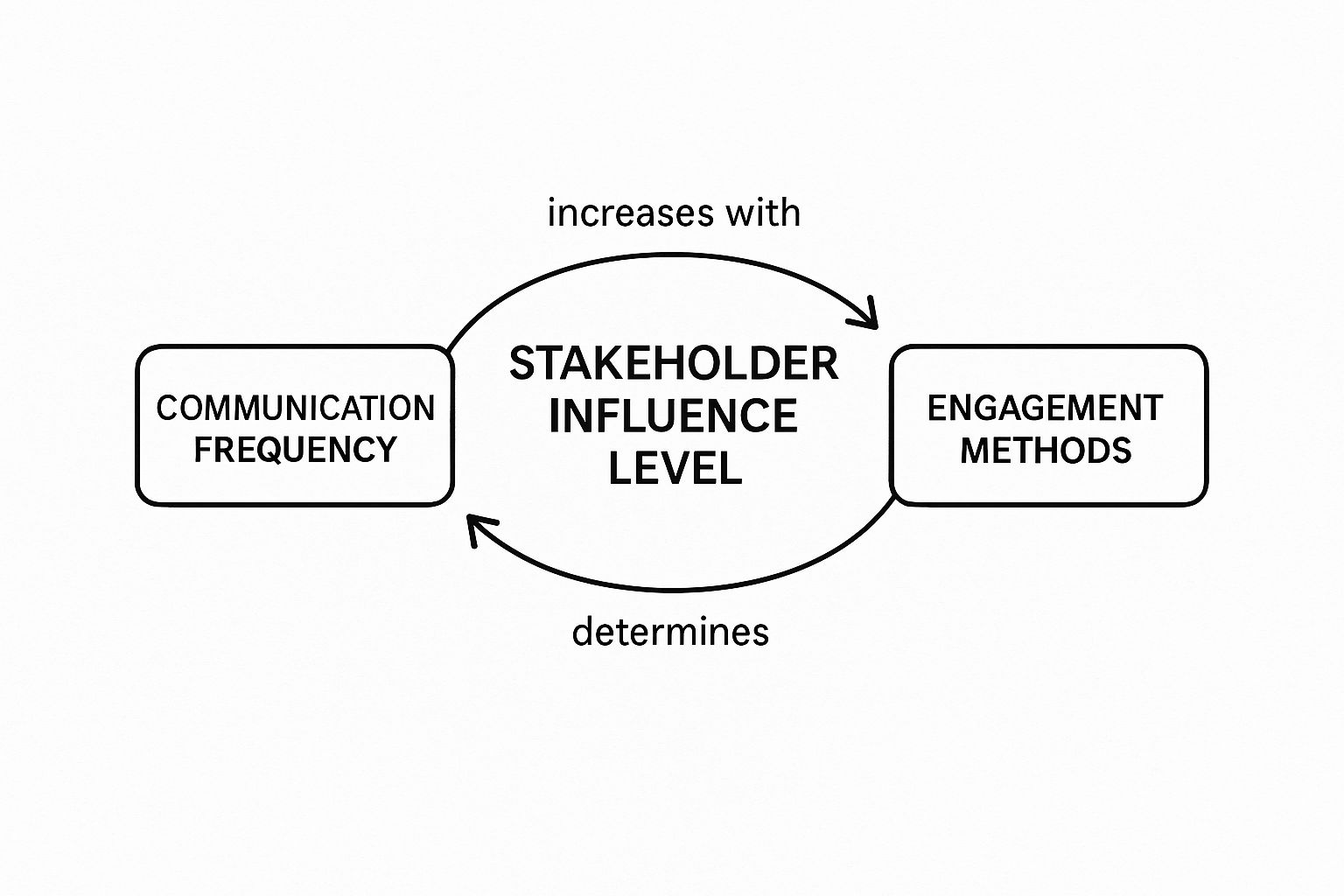Why Most Projects Fail Before They Even Start
Let’s begin with a hard truth: many projects are set up to fail long before anyone writes a line of code or lays the first brick. The real culprit isn’t a technical mistake or a miscalculation in the budget. It’s a failure to account for the people involved. The silent doubt of an executive, an end-user’s unvoiced fears, or a department head’s conflicting priorities can create unseen obstacles that stop even the most solid plans in their tracks.

The Myth of the Standard Update
We’ve all seen it happen. A team sends out a weekly email update or holds a quarterly check-in, thinking they’ve covered their bases for keeping everyone informed. But this approach often confuses broadcasting information with actual communication. It’s a one-way conversation that almost never reveals what stakeholders are truly thinking or worrying about. A stakeholder communication plan isn’t about just creating a distribution list; it’s about engineering a series of productive dialogues.
Think about a project to roll out new enterprise software. The IT team is focused on efficiency and security. The finance department sees a major expense hitting their budget. Meanwhile, the sales team worries the new tool will slow them down and affect their commissions. A generic “deployment progress” email speaks to none of these distinct, competing concerns. Without a specific approach, the finance team might delay budget approvals, and the sales team could quietly sabotage the rollout, killing the project simply by not using the new tool.
Turning Skeptics into Champions
The real breakthrough comes when you approach stakeholder engagement as a strategic campaign. This is less about ticking boxes in a project plan and more about understanding what motivates people, much like you would with potential customers. This idea of understanding motivations is something we explore in our guide on the lead qualification process, which is built on similar principles. You have to anticipate their concerns and explain the project’s value in a way that resonates with them.
For instance, instead of talking to the CFO about technical specs, show them a projection of cost savings and improved operational efficiency. For the sales team, you could demonstrate how the new tool automates menial tasks, freeing up more of their time for actual selling. This proactive, tailored communication can turn potential blockers into your most passionate supporters.
The data backs this up. Research shows that 75% of successful projects report high levels of stakeholder involvement and buy-in right from the start. This really drives home the importance of creating a solid stakeholder communication plan before you do anything else. You can read the full research about gaining buy-in on Unboxed Technology.
Finding the Hidden Players Who Actually Control Your Project
Your project’s success often hinges on people whose names never show up on the official org chart. Most project managers can easily list the obvious stakeholders: the sponsor, key users, and department heads. But real influence often comes from the hidden players who operate behind the scenes. The first move in building a solid stakeholder communication plan is to do a bit of detective work and map out these informal power structures.
Think about the executive assistant who manages the CEO’s calendar and attention, or that senior engineer everyone quietly consults before making a technical decision. These people have significant, though unofficial, power. For instance, on a software migration I managed, we hit unexpected resistance from the sales team. It wasn’t the VP of Sales blocking us; it was a highly respected veteran salesperson whose casual skepticism soured the whole department. Once we identified him and addressed his concerns, the team’s attitude changed almost overnight.
Mapping Influence and Interest
Just identifying these individuals isn’t enough. You also have to figure out where they stand in relation to your project. This means understanding both their level of interest and their ability to influence what happens. Some people might be very interested but have little power, while others have immense power but are only slightly interested.
To get a clearer picture, you can map out how a stakeholder’s influence level should guide your communication frequency and engagement methods.

This kind of visual makes it obvious that a one-size-fits-all communication strategy is set up to fail. To help organize this analysis, a stakeholder matrix is an extremely useful tool. It pushes you to go beyond simple identification and think strategically about how you’ll manage each relationship. This analysis is critical; recent research shows that a lack of strategic alignment is a huge reason for project failure, with a 67% rate of underperforming transformations in the last five years.
The Stakeholder Analysis Matrix
To make this process more concrete, let’s look at a stakeholder analysis matrix. This framework helps you categorize stakeholders so you can adjust your communication for the best results.
Stakeholder Analysis Matrix: Influence vs Interest Framework
A comprehensive framework showing how to categorize stakeholders based on their level of influence and interest in your project.
| Stakeholder Type | Influence Level | Interest Level | Communication Approach | Engagement Frequency |
|---|---|---|---|---|
| Promoters | High | High | Collaborate closely and involve them in key decisions. Treat them as partners. | Daily / Weekly |
| Defenders | High | Low | Keep them satisfied and consult on major issues that affect them. Don’t overwhelm them with details. | Weekly / Bi-Weekly |
| Latents | Low | High | Keep them informed with regular, automated updates. They are your potential champions. | Monthly |
| Apathetics | Low | Low | Monitor their sentiment but provide only minimal, need-to-know updates. | As needed |
Using a matrix like this ensures you aren’t wasting energy on low-impact players or, even worse, ignoring the hidden influencers who can quietly determine your project’s fate. By thoughtfully categorizing each person, you can focus your efforts where they matter most.
Speaking Their Language: Messages That Actually Land

If you’ve ever sent a generic, one-size-fits-all project update, you know it’s like shouting into a crowded room—most people just tune it out. Once you’ve identified your key players, the real work begins: crafting messages that speak directly to what they care about. A solid stakeholder communication plan isn’t just about what you’re announcing; it’s about framing that announcement in a way that resonates with each person receiving it.
This means you need to translate the same project milestone into several distinct narratives. For instance, announcing that your software beta is complete isn’t a single event. It’s a collection of different messages waiting to be shaped. The CFO doesn’t need a rundown of new features; they need to know how this achievement keeps the project on budget and brings you one step closer to seeing a return on investment. The conversation with them should revolve around financial metrics and risk management.
Translating Milestones for Different Audiences
Your communication has to connect with what each stakeholder group truly values. The average employee already deals with 10 planned changes annually, so they are primarily looking for clarity on how your project will affect their day-to-day tasks.
Let’s stick with the software beta announcement and see how we can tailor it for different groups:
- For the Head of Sales: You need to talk about competitive advantage. Try something like, “The new lead-scoring feature in the beta is showing a 15% higher accuracy rate in our initial tests. This will help your team focus their energy on the highest-value prospects.”
- For the End-Users (like the Customer Support team): Focus on making their jobs easier. You could say, “We’ve successfully integrated the knowledge base into the main dashboard, which will cut down on ticket resolution time. Your feedback on the beta will be vital for making it even better.”
- For the IT Department: Highlight stability and security. A good message would be, “The beta has cleared all initial security audits and is running stably in the test environment, which keeps us on track for a smooth and secure deployment.”
Each message delivers the same core news—the beta is ready—but it’s framed to answer the unspoken question on everyone’s mind: “What’s in it for me?” Learning how to create these personalized messages is a key skill. The principles behind personalized email marketing strategies for engagement offer great insights that can be applied here. By focusing on individual needs and perspectives, as outlined in many internal communication best practices, you build buy-in and support one conversation at a time.
Building Communication Channels People Actually Engage With
Having perfectly crafted messages doesn’t mean much if you send them into a void. An effective stakeholder communication plan is about more than just scheduling meetings or blasting emails; it’s about creating conversations in places people actually pay attention. You have to meet them where they are, using the tools and methods they prefer.
Think about it this way: you wouldn’t try to have a serious, personal conversation over a quick text message. By the same token, a static, formal dashboard isn’t the right way to communicate a complex project change to an already nervous team. The channel needs to fit both the message and the audience.
Matching the Method to the Moment
The real skill is in diversifying your communication based on the specific context and what you know about your stakeholders. Not every single update needs a full-blown meeting, which can be a huge drain on everyone’s time. With the average employee already dealing with 10 planned organizational changes a year, being respectful of their schedule is a must.
Here are a few practical scenarios for pairing the right channel with the right stakeholder:
- For high-influence, high-interest executives: Forget long emails they’ll never open. A scheduled, focused 15-minute one-on-one call or a clean, visual report is much more effective for getting your point across quickly.
- For hands-on end-users: Get them involved directly. Interactive workshops or casual “office hours” where they can ask questions and give immediate feedback are incredibly valuable. This creates a genuine two-way dialogue and makes them feel like their input truly matters.
- For departments with low interest but high influence: They need to be kept in the loop without being overwhelmed. An automated, high-level dashboard that displays key project metrics is often enough to satisfy their need for information without adding clutter to their day.
Creating Sustainable Rhythms and Feedback Loops
Your aim should be to set up a communication rhythm that feels natural and consistent, not like a forced march of updates. It should build trust over time but also be flexible enough to change when needed. A huge part of this rhythm is creating genuine opportunities for feedback. This is more than just sticking a “Q&A” slide at the end of a presentation; it’s about making dedicated space for honest input.
For example, after you hit a major project milestone, try sending a quick, two-question survey to a key group of stakeholders. Ask for their take on how things went. This not only gives you useful insights but also shows that you care about their perspective beyond just keeping them “informed.” For some fresh ideas on making these interactions more engaging, you can find some creative meeting engagement ideas that help turn passive listeners into active contributors.
When you thoughtfully choose your channels and intentionally build in opportunities for real dialogue, you stop just broadcasting information and start building a true project partnership.
Learning From Organizations That Got It Right
Some organizations just seem to have a knack for communication, turning otherwise complex projects into celebrated successes. When you look closely at these real-world examples, you can see what makes a stakeholder communication plan genuinely effective. It’s not about having a bigger budget or a larger team; it comes down to a deep, contextual understanding of the people involved.

Case Study: A Government Initiative That Succeeded
Let’s look at a government agency that was tasked with rolling out new environmental regulations affecting hundreds of small businesses. The standard approach would have been to simply announce the new rules and compliance deadlines. But they did something different. They kicked things off with a series of town hall meetings, not to present, but to listen. They even invited the most vocal critics to join advisory groups.
This strategy was a game-changer for two big reasons:
- It gave the agency priceless insights into the real-world operational headaches these businesses were facing.
- It turned potential opponents into partners who helped design a phased rollout plan that was both practical and effective.
This kind of proactive engagement is a growing trend. According to the OECD, stakeholder engagement quality in regulation has measurably improved over the last decade. The average score for subordinate regulations climbed from 1.95 out of 5 in 2014 to 2.16 in 2024, marking a slow but steady move toward more inclusive communication. You can learn more about these OECD regulatory findings on their official site.
Case Study: A Corporate Transformation That Stuck
Now for a corporate example. A well-established scientific organization needed to completely overhaul its old-school publishing methods. Instead of the top brass just handing down orders, they created a “solution-finding” initiative. They briefed 95 leaders on the overall vision and gave them toolkits to spark discussions within their own teams.
Then came the masterstroke: they asked for volunteers to create eight cross-functional solution teams. More than 100 employees put their hands up, becoming the very architects of the new system. This bottom-up approach meant the final processes weren’t just well-designed; they had automatic buy-in from the people who would use them daily. This story really shows the power of a solid stakeholder communication plan. For anyone looking to formalize their own process, a good internal communications plan template can be a great place to start.
These examples prove that the best plans aren’t about broadcasting information. They’re about building genuine partnerships.
Making Your Plan Work in the Real World
A brilliant stakeholder communication plan on paper is one thing; bringing it to life amidst tight deadlines and shifting priorities is a completely different challenge. This is where strategic thinking meets the pavement. The most successful project leaders I’ve worked with aren’t just great planners; they are disciplined executors who understand that a plan is a living document, not a static artifact.
Your first move is to get real about timelines and responsibilities. It’s easy to say, “We’ll send weekly updates,” but who is actually compiling the data, writing the summary, getting approvals, and hitting “send” every Friday at 4 PM? Assigning clear, individual ownership for each communication task is non-negotiable. This isn’t about creating bureaucracy; it’s about ensuring consistency when things get hectic.
From Strategy to Daily Workflow
Integrating your plan into existing project workflows is key to making it stick. If your team lives in Jira, your communication tasks should live there too. If they rely on a shared calendar, that’s where your deadlines need to be. The goal is to make communication a natural part of the daily routine, not an extra chore. For instance, you can automate reminders for key updates or build communication checkpoints into your project milestones.
A well-organized approach to integrating information from different sources is vital. If you’re managing customer data across various platforms, for example, the principles discussed in our guide on customer data integration best practices can offer some valuable parallels. This level of structured engagement is becoming a global standard. For example, the United Nations emphasizes this discipline for major global initiatives. When implementing large-scale frameworks like the 2025 System of National Accounts, countries are specifically guided to create and execute detailed stakeholder engagement plans to ensure alignment and success. You can explore more about this UN implementation strategy to see how these principles apply on a massive scale.
To help you get started, here’s a practical timeline you can adapt. It lays out the key activities needed to get your communication plan off the ground and keep it running smoothly.
Communication Plan Implementation Timeline
| Phase | Key Activities | Timeline | Success Metrics | Responsible Party |
|---|---|---|---|---|
| Phase 1: Foundation & Kick-Off | Finalize communication plan. Hold a kick-off meeting with the core project team. Assign owners for all communication tasks. Set up tracking in project management tools. | Week 1 | 100% of tasks assigned. Plan loaded into Jira/Asana. Kick-off meeting completed with 90%+ attendance. | Project Manager |
| Phase 2: Initial Rollout | Send first project newsletter. Launch internal project update page (e.g., Confluence). Hold first round of stakeholder one-on-one check-ins. | Weeks 2-4 | First newsletter sent with >40% open rate. Update page receives >50 views. 80% of high-priority stakeholders contacted. | Comms Lead |
| Phase 3: Ongoing Execution & Monitoring | Maintain regular communication cadence (weekly updates, monthly reports). Monitor feedback channels (surveys, email). Track engagement metrics (views, clicks, replies). | Weeks 5-12 | 95% of planned communications delivered on time. Engagement metrics meet or exceed baseline targets. | Project Team |
| Phase 4: Mid-Project Review & Adjustment | Conduct a mid-project survey to gather feedback. Review plan effectiveness with the core team. Adjust communication channels, frequency, or messaging as needed. | Week 13 | Survey completed with >50% response rate. Action items for adjustment are created and assigned. | Project Manager |
| Phase 5: Sustained Momentum & Close-Out | Continue adjusted communication plan. Prepare and distribute final project report and lessons learned. Conduct final stakeholder satisfaction survey. | Week 14 – Project End | Sustained or improved engagement. Final report acknowledged by key stakeholders. Positive trend in satisfaction scores. | Comms Lead |
This table shows how a plan can be broken down into manageable phases, each with clear goals and owners. This structure helps ensure nothing falls through the cracks, especially when the project gets busy.
Maintaining Momentum and Accountability
Momentum is fragile. A project can lose steam if a key stakeholder changes roles or if unexpected complexities arise. To counter this, build in regular, lightweight review sessions for the communication plan itself. A quick 15-minute check-in every two weeks can help you ask: Are our messages still landing? Are we using the right channels? Is anyone becoming disengaged?
This proactive approach helps you adapt before small issues become major project risks. It’s about creating a sustainable system that supports your project from start to finish. For insights into how real-world professionals apply these principles, explore a comprehensive guide to entrepreneurial communication, which offers practical advice on keeping various stakeholders aligned and engaged through the ups and downs of any venture. By focusing on disciplined execution and continuous adjustment, you transform your plan from a document into a powerful tool for project success.
Key Takeaways
A great stakeholder communication plan isn’t a document you create once and file away; it’s a living part of your project. It’s really about managing relationships and understanding the people who can make or break your work. The goal isn’t just to send out updates, but to foster real dialogue and figure out what actually motivates each person.
Your Actionable Checklist
Instead of a strict set of rules, think of these points as a practical roadmap to keep your communication sharp and effective. These are lessons learned from real projects.
- Prioritize People Over Process: Look beyond the org chart to identify both official and unofficial influencers. I once saw a new software rollout nearly fail because a single, highly respected salesperson wasn’t on board and quietly influenced their entire team against it. Finding and winning over those key players early is your best shield against this kind of surprise resistance.
- Translate, Don’t Just Transmit: Sending the same generic update to everyone is a missed opportunity. You have to frame your message in a way that resonates with the recipient. When talking to the CFO, focus on ROI and staying within budget. For a user, explain how the change will make their daily work simpler. This simple act of tailoring your message transforms a one-way announcement into a two-way conversation.
- Match the Channel to the Context: Your default shouldn’t always be email. A high-influence executive might only have time for a 15-minute summary call, whereas a hands-on technical team will get more value from an interactive workshop. Showing you respect their time and communication preferences builds goodwill and strengthens your partnership.
Keeping Your Plan Alive
A plan sitting on a shelf is useless. It needs to adapt as your project unfolds. Make a habit of scheduling quick, regular check-ins on your communication strategy. Ask yourself: Is engagement dropping? Are you hearing rumors or misinformation? These are signals that your plan needs a tune-up.
If a stakeholder seems to be pulling back, don’t just wait and hope for the best. Reach out to them directly. Often, a quick, informal conversation can clear up a misunderstanding before it grows into a genuine project risk. The aim is to constantly improve your approach, making you a more effective leader on every project.
Even with the best plan, simply knowing who is available can be a major hurdle. This is where tools that track team availability are incredibly helpful. For instance, teams on Jira can use Resolution’s Out of Office Assistant to ensure that if a stakeholder is away, critical tasks and approvals are automatically passed to someone else. This prevents communication dead ends and keeps your project from stalling.
